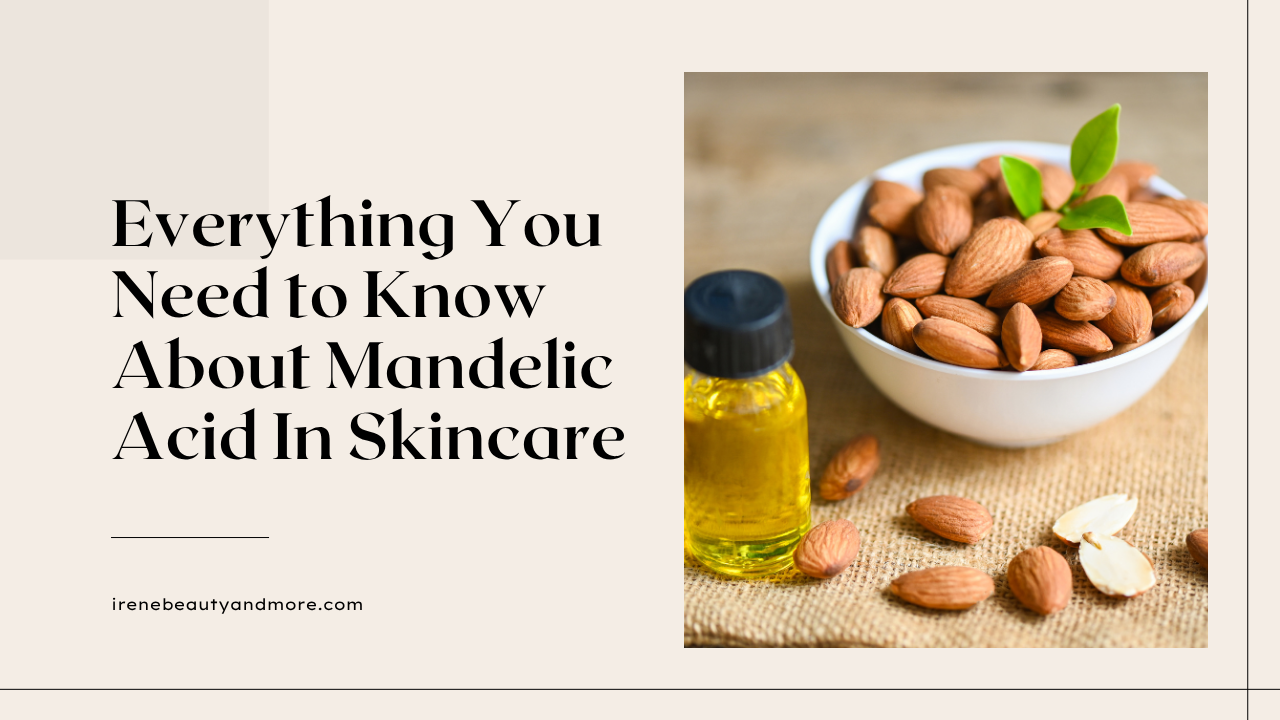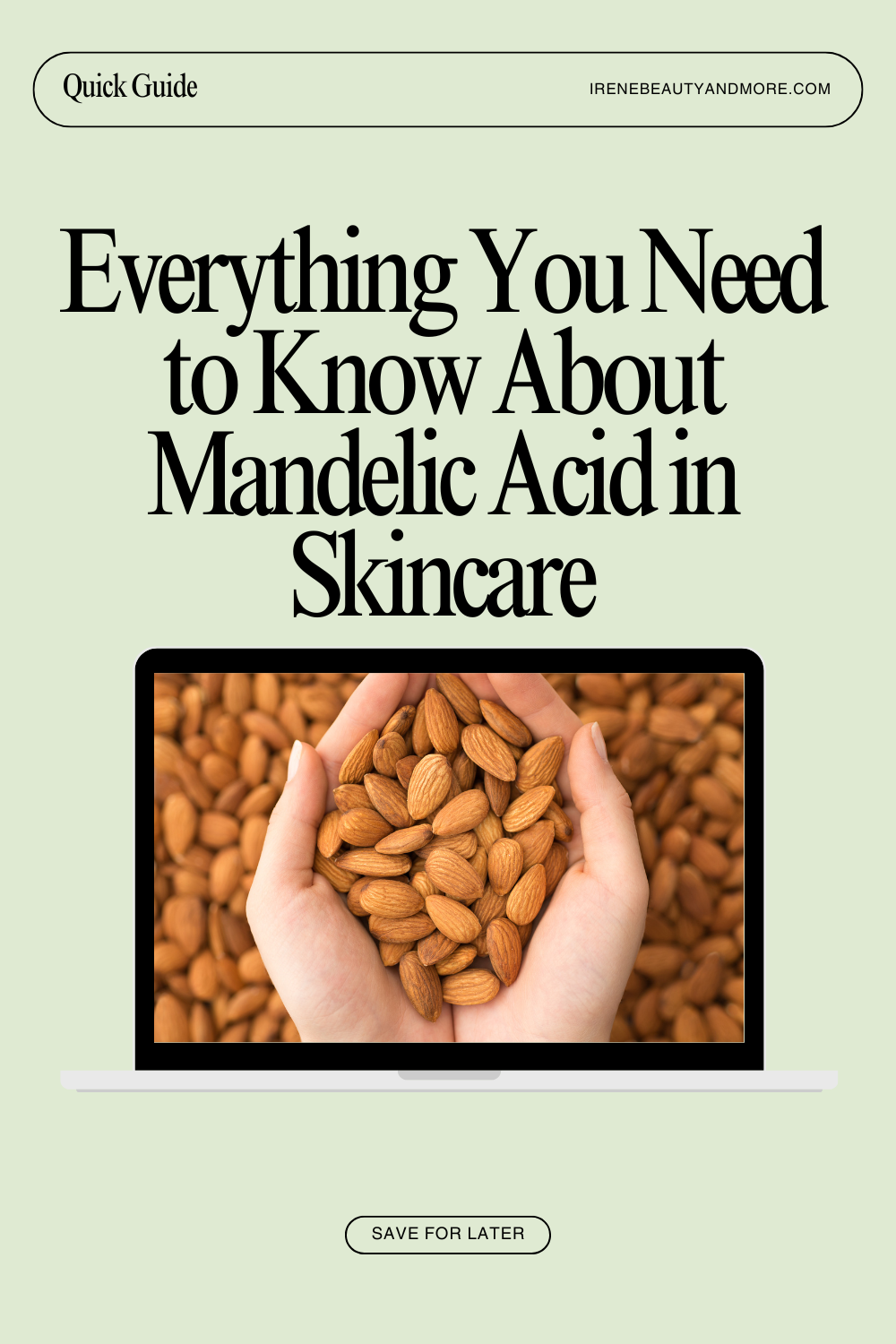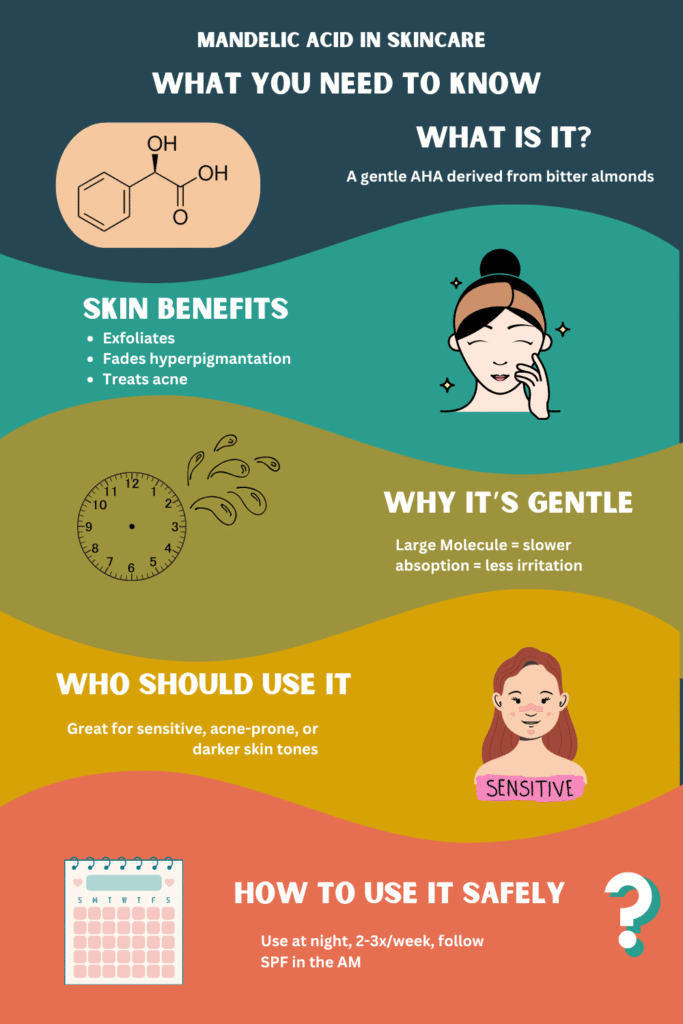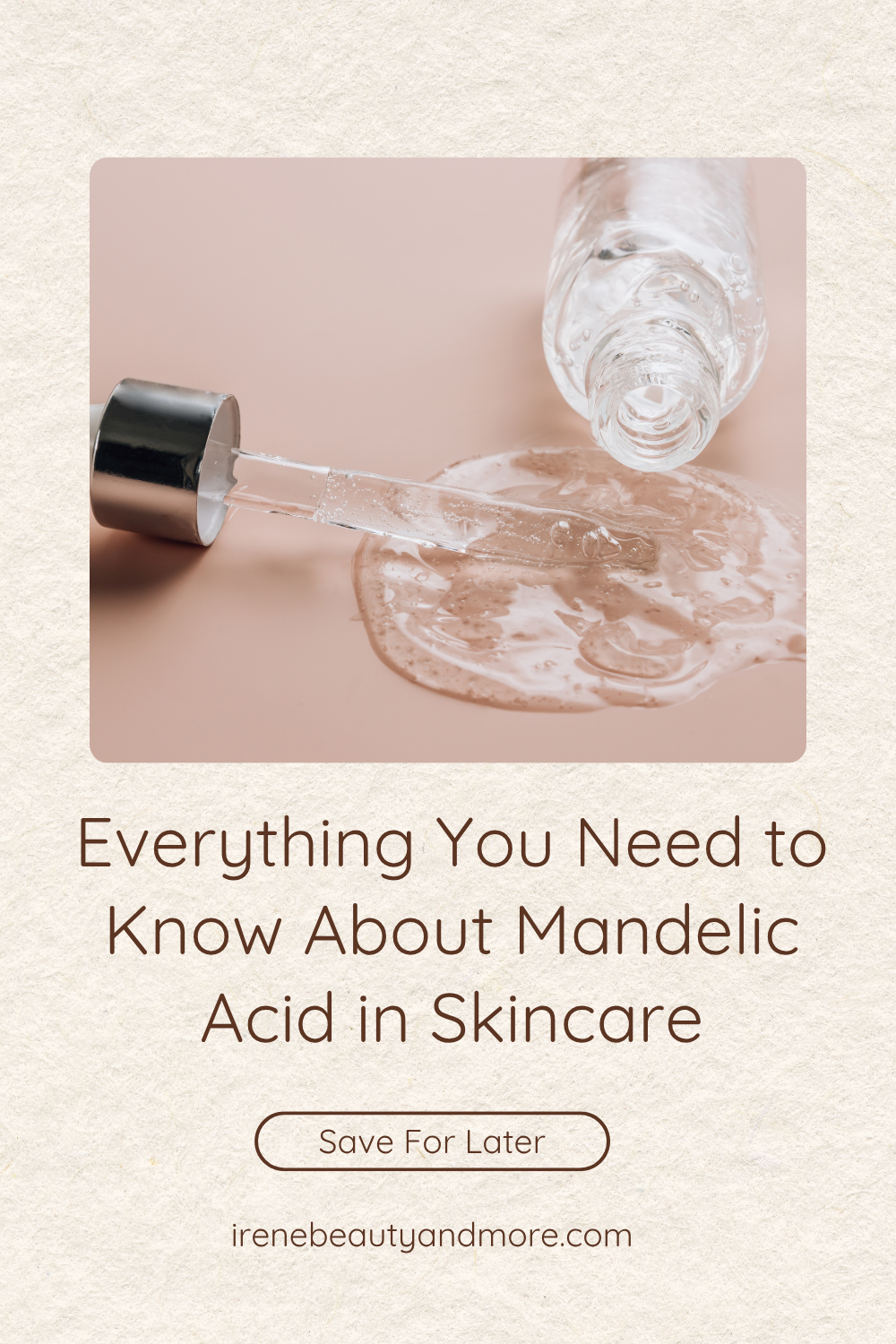Mandelic acid is an alpha hydroxy acid (AHA) derived from bitter almonds, gaining recognition for its ability to deliver smoother, brighter skin while being gentler than many other AHAs. Known for its mild exfoliating properties, this acid is effective in treating a variety of skin concerns, including acne, hyperpigmentation, and signs of ageing. This post explores what mandelic acid is, its benefits, how it works, and how to incorporate it into your skincare routine.

What Is Mandelic Acid?
Mandelic acid is an AHA, a class of exfoliants known for their ability to dissolve the bonds between dead skin cells on the surface of the skin, allowing them to be sloughed away. This acid stands out due to its larger molecular size compared to other AHAs like glycolic acid. This means it penetrates the skin more slowly and is less likely to cause irritation, making it an excellent choice for individuals with sensitive skin.
It is derived from bitter almonds and has been used for centuries due to its brightening and anti-inflammatory properties. While its primary function is exfoliation, mandelic acid is known to provide multiple benefits, making it a versatile ingredient in skincare formulations.
Mandelic Acid
An alpha hydroxy acid (AHA) derived from bitter almonds. Known for its large molecular size and gentle exfoliation properties.
AHAs (Alpha Hydroxy Acids)
Water-soluble acids (like glycolic or lactic acid) that exfoliate the skin by breaking down bonds between dead cells.
Molecular Weight
The size of a molecule—mandelic acid’s larger size (152 g/mol) means slower skin penetration and reduced irritation risk.
Exfoliation
The process of removing dead skin cells to improve texture, tone, and absorption of other products.
Post-Inflammatory Hyperpigmentation (PIH)
Dark marks left behind after acne or irritation—mandelic acid is often used to fade them gently.
How Mandelic Acid Works
As an exfoliating agent, this acid breaks down the bonds between dead skin cells, speeding up the skin’s natural exfoliation process. This process helps remove dull, dry skin, revealing a brighter, smoother complexion underneath. Unlike other exfoliating acids, mandelic acid’s larger molecule size means it penetrates more slowly, which reduces the potential for irritation. This makes it a great option for people with sensitive skin, rosacea, or redness.
In addition to exfoliation, it has antibacterial properties that help reduce acne-causing bacteria on the skin’s surface, making it a popular treatment for acne-prone individuals. It can also help with the appearance of hyperpigmentation, fine lines, and uneven skin texture by encouraging cell turnover.

Benefits of Mandelic Acid
Gentler Than Other AHAs:
This acid is much milder than more aggressive AHAs like glycolic acid. Its slow penetration makes it ideal for sensitive or reactive skin, allowing you to enjoy exfoliating benefits without the irritation that often accompanies stronger acids.
Treats Acne and Breakouts:
It has antimicrobial properties that target the bacteria responsible for acne, helping to clear breakouts. Its ability to unclog pores also prevents the formation of new acne.
Fights Hyperpigmentation and Uneven Skin Tone:
Mandelic acid can help lighten dark spots, acne scars, and pigmentation by accelerating the turnover of skin cells. This regular exfoliation helps to fade dark marks and even out the skin tone over time.
Improves Skin Texture:
Mandelic acid promotes the removal of dead skin cells, resulting in smoother, more even-textured skin. Regular use can reduce the appearance of fine lines, giving the skin a more youthful appearance.
Hydrates and Brightens the Skin:
Though primarily an exfoliant, mandelic acid also helps to hydrate the skin by drawing moisture to the surface, which gives the skin a healthy, radiant glow.

How to Use It in Your Skincare Routine
Incorporating this acid into your routine is easy, but like with all acids, it’s important to start slow to avoid irritation. Here’s how to use it:
Patch Test First: Before introducing it to your skincare routine, always do a patch test to ensure you’re not allergic or overly sensitive to it. Apply a small amount of the product to a discreet part of your body, such as the inside of your elbow, and wait 24 hours.
Cleanse and Tone: As with any acid, start by cleansing your skin with a gentle cleanser. You can use a toner afterwards to help balance your skin’s pH before applying this acid.
Serum or Treatment: Mandelic acid is often found in serums and treatments. Apply it to your face after toning and before moisturising. Start by using it 2-3 times a week, then gradually increase the frequency if your skin tolerates it.
Follow with Sunscreen: Because AHAs make your skin more sensitive to the sun, it is crucial to apply sunscreen every morning when using this acid. Even if you’re only using it at night, it’s important to wear sunscreen during the day to prevent sun damage.
Is mandelic acid safe for sensitive skin?
Yes! Its larger molecular size allows it to exfoliate slowly and gently, making it ideal for sensitive, rosacea-prone, or darker skin tones.
Can I use mandelic acid daily?
Start with 2–3 times per week. If your skin tolerates it well, you can build up to daily use, especially in low concentrations (5–10%).
Should I use mandelic acid in the morning or at night?
Nighttime is best to avoid sun sensitivity and allow for deeper repair—but always wear SPF if used during the day.
Can I use mandelic acid with retinol or vitamin C?
Avoid using it with strong actives at the same time. Alternate nights or apply at different times of day to reduce the risk of irritation.
Potential Side Effects
While this acid is generally well-tolerated, some users may experience mild irritation or redness, especially if they overuse the product. Start with lower concentrations (around 5-10%) and gradually build up as your skin becomes accustomed to the acid.
Additionally, if you have very dry or compromised skin, you may want to use mandelic acid in conjunction with a hydrating moisturizer to prevent dryness or irritation.
Mandelic Acid vs. Other Exfoliating Acids
Mandelic Acid vs. Glycolic Acid: Glycolic acid is another popular AHA, but it has a smaller molecular structure, meaning it penetrates the skin more quickly and can be more irritating, especially for those with sensitive skin. Mandelic’s larger molecular size makes it gentler and less likely to cause irritation while still delivering effective exfoliation.
Mandelic Acid vs. Salicylic Acid: Salicylic acid is a beta hydroxy acid (BHA) that is oil-soluble, making it excellent for treating acne by penetrating deep into the pores. While mandelic also helps with acne, salicylic acid is often more effective at addressing deep-rooted blemishes. However, mandelic acid may be better for those with sensitive skin.
Did You Know?
Mandelic acid is both an AHA and has antibacterial properties—making it uniquely effective for both exfoliation and acne control, especially in adult or hormonal acne!
My Favourite Mandelic Acid Products

The Ordinary – Mandelic Acid 10% + HA
This cult-favourite from The Ordinary delivers 10% mandelic acid in a lightweight, water-based formula ideal for beginners. Its larger molecular size ensures a slow, gentle exfoliation that helps improve texture and uneven tone without irritating sensitive skin. Added hyaluronic acid boosts hydration, making this an excellent pick for dry or reactive skin types.

Revox – Mandelic Acid 10% + HA
Revox offers a budget-friendly alternative with a similarly minimal 10% mandelic acid solution. The formula is clean and no-frills, perfect for those who want straightforward exfoliation without extra ingredients. Its gentle action makes it suitable for oily and acne-prone skin, especially if you’re just starting with acids and want to avoid harsh side effects.

Good Molecules – Mandelic Acid Serum
Though marketed as a retinol treatment, this gentle cream also includes mandelic acid for a dual-action resurfacing effect. It’s ideal for sensitive or dry skin types who want the benefits of retinol and mild exfoliation in one step. Fragrance-free and soothing, this product supports smoother, clearer skin over time without the sting of traditional actives.
Conclusion: Is Mandelic Acid Right for You?
Mandelic acid is an excellent exfoliator for those seeking a gentler alternative to harsher AHAs. Its ability to treat acne, reduce pigmentation, improve skin texture, and hydrate makes it a versatile and valuable addition to many skincare routines. If you’re looking for an acid that can help reveal brighter, smoother, and more even skin without the irritation commonly associated with exfoliating acids, this acid may be the perfect option for you.
Bear in mind that some of the links in this post are affiliate links and if you go through them to make a purchase I will earn a commission. Keep in mind that I link these companies and their products because of their quality and not because of the commission I receive from your purchases. The decision is yours, and whether or not you decide to buy something is completely up to you.






